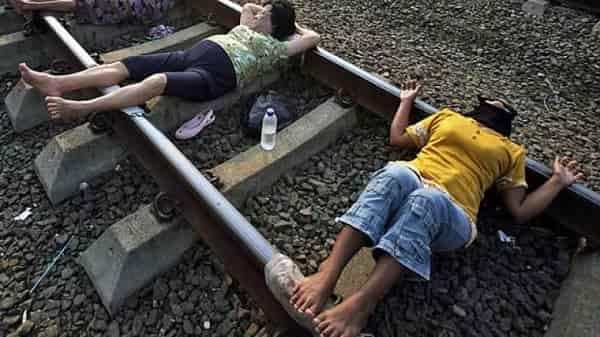Railway Track Therapy in Indonesia: A Unique and Controversial Health Practice

In recent years, an unconventional health trend known as Railway Track Therapy has gained attention in Indonesia. This unusual practice involves people lying on or near railway tracks, believing that the electric currents from the tracks will provide therapeutic benefits.
While intriguing, this practice has sparked debate among health professionals, railway authorities, and the public alike. In this article, we’ll delve into the origins of railway track therapy, its perceived benefits, the risks involved, and its impact on Indonesia’s health culture.
What is Railway Track Therapy?
Railway track therapy refers to the practice of individuals lying on or sitting near active or inactive railway tracks, hoping to absorb low-voltage electric currents. Practitioners believe that the electrical energy from the rails can alleviate various ailments, from chronic pain to nervous system disorders. The therapy has roots in traditional beliefs about the healing powers of electricity, combined with Indonesia’s deep connection to alternative medicine.
The practice typically involves people gathering at a railway station or an isolated track, lying down on the steel rails, and staying there for several minutes. They believe that the small amounts of electricity flowing through the track can help reset their body’s energy field, similar to the principles of acupuncture or magnetic therapy.
Origins of Railway Track Therapy in Indonesia
Although the exact origins of railway track therapy in Indonesia are difficult to trace, it appears to have started in rural areas where access to modern healthcare is limited. The practice gained popularity through word-of-mouth, social media, and local news reports, with many testimonials from individuals claiming miraculous recoveries from ailments like arthritis, joint pain, and even paralysis.
Indonesia, a country known for its traditional medicine practices such as jamu (herbal medicine) and alternative therapies like cupping, found railway track therapy appealing due to its perceived accessibility and simplicity. The growing popularity of the practice is a reflection of the Indonesian population’s trust in non-conventional treatment methods.

Perceived Benefits of Railway Track Therapy
Supporters of railway track therapy claim numerous health benefits, most of which are anecdotal. Some of the most commonly reported advantages include:
– Pain Relief: Many people suffering from chronic pain, arthritis, or joint problems report feeling relief after undergoing railway track therapy.
– Improved Circulation: Practitioners believe that the low-voltage electric current stimulates blood circulation, helping to reduce inflammation and improve overall vitality.
– Nerve Stimulation: Similar to the effects of acupuncture, advocates of the therapy claim that the electric charge stimulates nerve endings, which may help with nerve-related issues.
– Boost in Energy Levels: Some participants claim to feel more energized and rejuvenated after each session, attributing it to the rebalancing of the body’s energy fields.
While these claims are largely unproven by scientific research, the testimonials have led many people to try the practice, hoping for similar results.
Risks and Dangers
Despite its growing popularity, railway track therapy is not without significant risks. Critics, including health experts and railway officials, warn that the practice is not only ineffective but also potentially life-threatening.
– Risk of Electrocution: Although railway tracks are not constantly electrified, certain sections, particularly near urban areas, can carry live electrical currents. Even a small voltage can cause serious injury or death.
– Train Accidents: Lying on railway tracks presents an obvious danger—being struck by an oncoming train. Even in areas where trains do not pass frequently, the unpredictability of train schedules makes the practice inherently dangerous.
– Lack of Scientific Evidence: There is no conclusive scientific research to back up the health benefits claimed by railway track therapy practitioners. This leads many experts to dismiss it as a placebo effect or psychological relief rather than a genuine medical treatment.
– Legal Concerns: In some areas of Indonesia, local authorities have started cracking down on the practice, issuing warnings and arresting individuals who attempt to access railway tracks for therapy. Not only does this endanger lives, but it also disrupts train schedules and poses a risk to railway employees.
The Cultural Context of Alternative Medicine in Indonesia
To understand the appeal of railway track therapy in Indonesia, one must consider the country’s long-standing relationship with traditional medicine. For centuries, Indonesians have relied on herbal treatments, massage, and spiritual healing to address physical and mental health issues. The country’s diverse cultural landscape, with influences from Indigenous traditions, Hinduism, Buddhism, and Islam, has fostered an environment where alternative medicine is widely accepted.
However, the increasing popularity of railway track therapy highlights a larger issue: the lack of access to affordable, modern healthcare in rural and underprivileged areas. Many people turn to alternative methods due to high medical costs, long wait times, or a shortage of doctors. This environment makes it easier for unconventional practices to flourish, even when they pose significant risks.
Railway Authorities and Public Safety
In response to the rise of railway track therapy, Indonesian railway authorities have made concerted efforts to raise public awareness about the dangers of this practice. Several campaigns have been launched, warning people about the legal and safety risks of trespassing on railway property. Railway stations and tracks are now monitored more closely, with signs and barriers set up to deter people from engaging in the therapy.
Some regions have also introduced penalties for those caught on railway tracks without permission, hoping that stricter enforcement will reduce the number of incidents. However, many practitioners remain undeterred, driven by their belief in the therapy’s healing potential.
A Controversial Practice with Deep Roots
Railway track therapy in Indonesia is a fascinating example of how alternative medicine practices can take root in modern society, even when they defy conventional logic and science. The practice reflects a broader cultural acceptance of alternative health treatments, especially in areas where access to formal healthcare is limited.
While the perceived benefits of railway track therapy may appeal to some, the risks involved are far too great to ignore. As awareness grows about the dangers, authorities and health professionals continue to emphasize the importance of safer, scientifically proven methods for treating chronic pain and other ailments.
Ultimately, while railway track therapy may fade in popularity over time, it serves as a reminder of the powerful role that culture, tradition, and belief play in shaping health practices, even in the face of modern advancements.
FAQ: Railway Track Therapy and Related Concepts
Q1: What is the railroad track technique?
The railroad track technique, often referred to in alternative wellness as Railway Track Therapy, involves using railway tracks as a conduit for grounding and energy healing. Participants walk, sit, or lie along inactive railway tracks, believing that the metal rails enhance the natural magnetic energy of the earth, promoting relaxation, mental clarity, and a sense of balance. This technique taps into ancient beliefs about the healing power of metals and modern wellness practices focused on reconnecting with nature.
Q2: What is the railway track used for?
Railway tracks, in a traditional sense, are structures that support and guide trains as they travel across distances. The tracks are made of steel rails laid on ties (or sleepers) and fastened to a solid base of ballast or concrete. The primary function of a railway track is to maintain the train’s direction and provide stability, allowing for efficient and safe transportation of goods and passengers. In the context of alternative wellness, these tracks are repurposed as tools for grounding and energy healing, though this is outside their intended use.
Q3: What is railway track stress?
In the context of engineering and physics, railway track stress refers to the mechanical stress exerted on railway tracks due to the weight of trains and environmental factors like temperature changes. This stress can lead to wear and tear, track deformation, or even buckling, particularly in extreme weather conditions. Maintenance practices, such as adjusting the tracks and reinforcing them, are essential to ensure safe and smooth train operations. In a wellness context, railway track stress is not typically a consideration, as practitioners use abandoned or inactive tracks for therapy.
Q4: Why is the railway track in an “I” shape?
Railway tracks are designed in an “I” or I-beam shape for structural efficiency. This shape, also known as a rail profile, helps distribute the weight of the train evenly across the track while maintaining strength and stability. The vertical section of the “I” (called the web) supports vertical loads, while the top and bottom flanges handle horizontal and torsional forces. This design minimizes material use while maximizing strength, ensuring that the track can handle the heavy weight of trains without bending or breaking.
